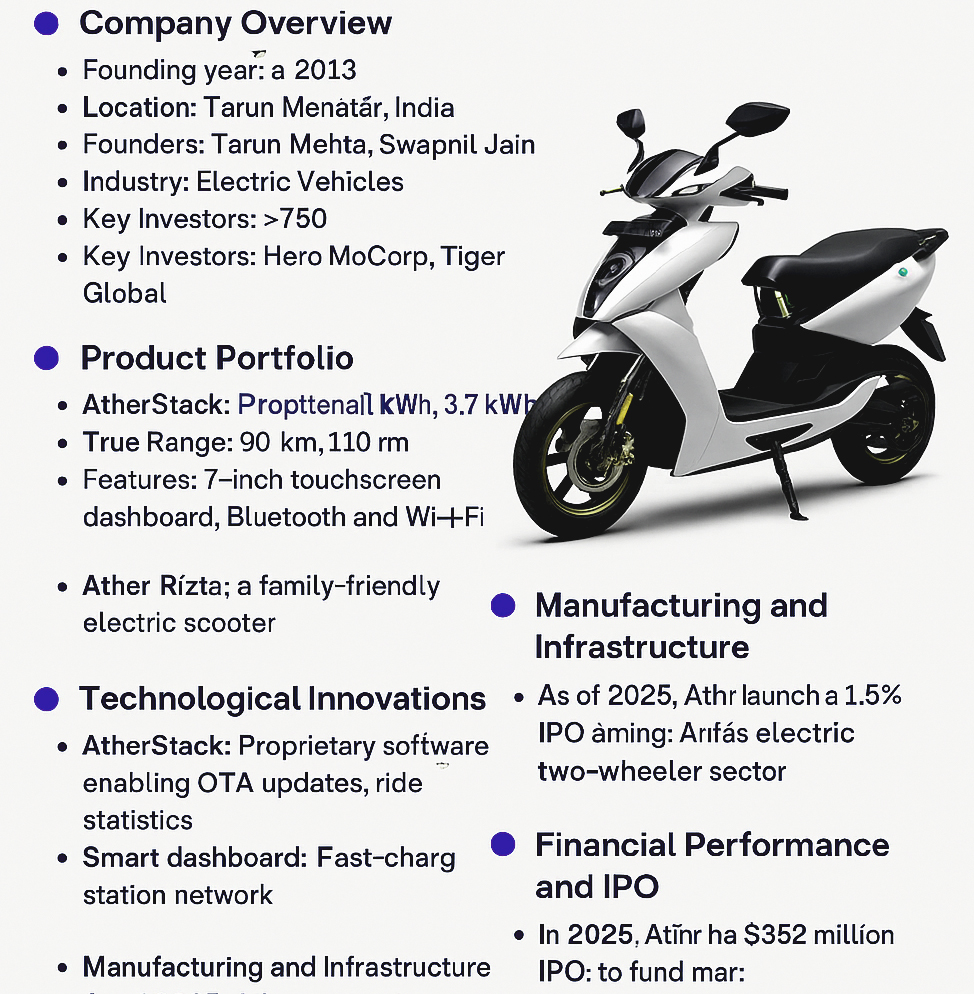Ather Energy, an electric vehicle (EV) startup based in Bengaluru, has made a name for itself as a prominent player in India’s rapidly evolving electric two-wheeler market. Ather was founded in 2013 by IIT Madras alumni Tarun Mehta and Swapnil Jain in Bengaluru (Karnataka, India) to design, develop and manufacture electric scooters with intelligence, features that address the requirements of Indian customers on the EV platform.
- Overview of the company
• Established: 2013
• Location: Bengaluru, Karnataka, India
• Founders: Tarun Mehta and Swapnil Jain
• Industry: Electric vehicles (Two-wheelers)
• Employees: Approx. 750
• Investors include: Hero MotoCorp, Tiger Global, GIC and others
• ‘s mission is to accelerate the use of sustainable mobility solutions in India through high-performance electric scooters with smart features, supported by appropriate charging infrastructure.
- Product Portfolio
Ather 450 Series
The Ather 450 series includes the Ather 450X and Ather 450S, Ather’s flagship products.
- Ather 450X:
o 2.9 kWh and 3.7 kWh battery options
o True Range: 90 km (2.9 kWh) & 110 km (3.7 kWh)
o Top Speed: 90 km/h
o Features: 7-inch touchscreen dashboard, Bluetooth and Wi-Fi connectivity, real-time navigation on the dashboard, reverse assist, and fast charging feature. - Ather 450S:
o 2.9 kWh battery
o Features: Bluetooth and Wi-Fi connectivity, mobile application for navigation, music control, and call control.
o Ather Rizta
Launched as an electric scooter for the entire family, the Ather Rizta is built with a spacious design for everyday commuters.
- Technological Innovations
emphasizes its innovation on technology in the pursuit of better user experience and vehicle performance.
- AtherStack: Proprietary software stack integration that includes features such as over-the-air (OTA) updates with features, ride statistics, and riding modes.
- Ather Grid: own set of fast charging stations throughout major cities across India allowing for easy charging for Ather
- Smart Dashboard: 7-inch touchscreen dashboard provides real-time information, navigation, connectivity.
- Manufacturing and Infrastructure
owns manufacturing plants in Whitefield, Bengaluru, and Hosur in Tamil Nadu. They have the capability to produce battery packs and assemble electric scooters whilst ensuring quality control and scalability.
The company is growing its Ather Grid network and aims to create a robust charging infrastructure that suits its expanding customer base. - Market Position and Competition
As of 2025, holds approximately 11.5% of India’s electric two-wheeler market share. It is behind competitors like Ola Electric, TVS Motor, and Bajaj Auto, however, it has differentiated its offering with premium features, technology, and a strong focus on customer experience and satisfaction.
The Indian electric two-wheeler market is anticipated to grow rapidly with a volume growth forecasted to increase by 25% by March 2026. Ather aims to take full advantage of this growth opportunity with continuous innovation and expansion of infrastructure.
- Financial Performance and IPO
In 2025, Ather launched a $352 million Initial Public Offering (IPO), one of the biggest IPOs in India’s EV sector. The IPO was successfully closed, in spite of a difficult market opening which saw shares fall over 4%, aided by strong uptake from institutional investors. Proceeds from the IPO will be primarily used to build a new manufacturing facility, fund research and development, and expand marketing.
- Challenges and Future Outlook
Challenges:
• Profitability: Ather will face challenges in obtaining profitability with estimated losses up to Rs 30,000 ($355) per vehicle.
• Market Competition: Ather will be competing against established players with aggressive pricing and more extensive distribution networks.
• Policy Changes: Reductions in government subsidies for electric vehicles can impact both consumer purchase patterns and company margins.
- Financial Performance and IPO
In 2025, Ather launched a $352 million Initial Public Offering (IPO), one of the biggest IPOs in India’s EV sector. The IPO was successfully closed, in spite of a difficult market opening which saw shares fall over 4%, aided by strong uptake from institutional investors. Proceeds from the IPO will be primarily used to build a new manufacturing facility, fund research and development, and expand marketing.
- Challenges and Future Outlook
Challenges:
• Profitability: Ather will face challenges in obtaining profitability with estimated losses up to Rs 30,000 ($355) per vehicle.
• Market Competition: Ather will be competing against established players with aggressive pricing and more extensive distribution networks.
• Policy Changes: Reductions in government subsidies for electric vehicles can impact both consumer purchase patterns and company margins.
Future Outlook
Ather Energy will capitalize on its technology and infrastructure to gain market share. The company will also add models, expand its charging infrastructure, and assess international opportunities. In achieving these goals, ongoing investment in research and development will be pivotal in maintaining its competitive edge.
Conclusion
Ather Energy is a reminder of the potential of the industry for electric mobility in India. With its focus on innovative approaches, quality, and customer experience, the company has developed a compelling place in an increasingly competitive electric two-wheeler market. While there are still challenges to overcome, Ather’s plans and the company’s commitment to sustainable mobility demonstrate that it will continue to be successful in the future.
Note: that this article was based solely on public information, as of May 2025. For current information, refer to official communications and financial disclosures.
![]()

